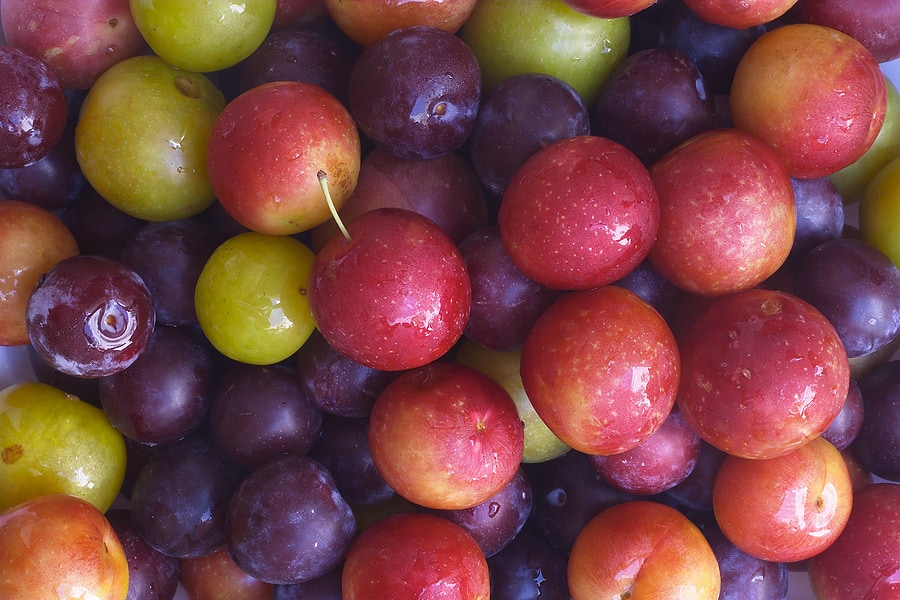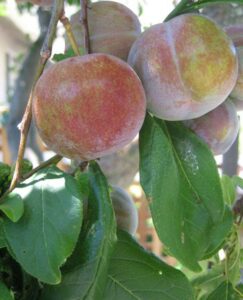There are all different, shapes, sizes, and colors of plums to be tried. Ripe plums can range in texture from firm to slightly soft. They can range in flavor from deliciously sweet to tasty- tart.
Plums can be pink, red, scarlet, purple, blue-black, green, yellow, or amber-skinned. Their flesh can be yellow, green, pink, red, orange, or a rainbow of the five. Plums can be round, oval, or heart-shaped and can range in size from as small as a grape to nearly as large as an apple.

Favorite plum recipe
How to Make Plum Jam for Beginners
How to serve plums
Plums can be eaten fresh out of hand as a snack or dessert. They also can be stewed or used in jellies, jams, sauces, puddings, crisps, cobblers, cakes, and tarts. Plums can be poached or baked like pears and peaches. Some plums can be dried and served as prunes.
Plums can be eaten fresh out of hand or cooked.
- Serve quartered or sliced in cream or milk.
- Slice and add raw to fruit salads.
- Fill cavities with soft cheese such as Brie.
- Use firm-ripe plums in poultry or fish salads.
- Use in fruit compotes, tarts, crisps, and cobblers.
- Stew for chutney preserves.
- Use in jams or jellies.
- Use in pies, cakes, puddings, muffins, and ice cream.
- Preserve in vinegar, particularly quetsche.
- Plums can replace cherries in most desserts.
Plums harvest season
The first plums of the season are ready for harvest in mid-summer and the last plums of the season are harvested nearly at the beginning of autumn.
Types of plums
There are more than 2,000 varieties of plums, some are purebred, and the majority are hybrids. Most plums can be traced to three important plum species: Japanese plums, American plums, and European plums.

Japanese plums
Japanese plums are the earliest plums of the season. These plums flower sometimes before the last frost of the season and are ready for harvest two to three months later. Japanese plums are round or heart-shaped and larger and juicier than European or American plums. The best-known Japanese-type plum–and one of the most popular plums in the world–is the Santa Rosa plum. It is red-skinned, yellowish-red fleshed, aromatic, and has a very sweet plum flavor. Japanese plums are actually misnamed; they are native to China.
American plums
American plums are native to North America. These are small plums with amber to bright red skins and amber-colored flesh. American plums are tart and used mostly for preserves. They are ready for harvest in midsummer. American plums are often hybridized with Japanese plums to produce larger, sweeter fruit.
European plums
European plums–also called common plums–ripen in late summer. European plums are medium-sized, oval-shaped, and dark blue or purple-red in color. They have firm, dense yellow or greenish-yellow flesh, and their stones do not cling to the flesh. European plums have extra high sugar content and are often made into prunes. They also are eaten fresh or used for canning and preserves.
Damson plums
Damson plums are similar to European plums but a different species. They are native to Europe and grew wild before the cultivation of European plums. Damson plums are small, blue-skinned, and rather acid and tart flavor. They are ideal for preserves, jams, and jellies. The dark yellow-skinned, freestone Mirabelle plum is a damson plum. The Mirabelle is grown mostly in northeastern France. It is used in tarts and preserves.
Gage plums
Green plums are also a type of European plum. They are round, green or golden-colored, and used for canning or eating fresh. Green plums are called Gages or greengages in England and Reine Claude in France.
Plums grow on deciduous trees that can reach from 15 to 20 feet tall. The plum’s leaf is burgundy colored and oval. The leaves are preceded in spring by white flowers. Plums can be clingstone, the flesh clings to the stone or freestone.

Choosing plums
Select plums with a pleasant aroma that are full-colored for the variety and yield to the slight pressure of the fingers. Ripe fruit will be slightly soft at the tip end. The skin should have a powdery “bloom”.
Avoid plums that are too hard, too soft, bruised, or stained. Avoid plums with cracks or blemishes, broken or shriveled skin, or brownish discoloration.
Amount. One pound of Japanese plums (4 or 5 plums) yields about 1½ to 2 cups of sliced fruit. One pound of European plums (12 to 15) yields about 2 cups of sliced fruit.
How to store plums
Refrigerate ripe plums for up to 4 or 5 days. Ripen plums at room temperature till the skin loses its shine; plums ripen quickly.
Freeze plums in light syrup. First, halve and pit the plums or cut the flesh away from the pits in quarters. The pits will impart a bitter taste.
How to prepare plums
Rinse plums before eating out of hand. To remove the pit, slice the fruit around the seam of freestone and semi-freestone varieties then twist the fruit in half and lift or cut out the pit. Cut the flesh of clingstone plums away from the pit.
To peel plums, dip them in boiling water for 30 seconds, lift out with a slotted spoon, and cool them in cold water. The skin will slip off.
Cooking plums
Do not remove plum skin before cooking, allow the skin and flesh to cook together to combine flavors.
Poaching
Rinse and then prick the skin of each plum, Simmer in poaching liquid until tender when pierced (7 to 10 minutes) for Japanese-type plums (3 to 5 minutes) for European-type plums.
Ways to serve plums
Plum flavor partners
Plums have a flavor affinity for allspice, black pepper, brandy, cardamom, cinnamon, crème fraîche, ginger, honey, nutmeg, orange, port wine, red wine, sour cream, white wine, and yogurt.
Plum nutrition
Plums are a good source of potassium and also supply vitamin C and riboflavin.
About plums
The plum is native to China and traveled westward out of Asia. The word damson marks the plum’s ancient cultivation in Damascus in modern-day Syria. The ancient Romans grew 300 varieties of plums. In the twelfth century, European Crusaders introduced plums throughout Europe. The common plum was introduced to America by European settlers.
The ancient Greek word for plums was proummon. That became prūnum in Latin which became prune in English. The old Germanic language word pflaume, became plommon in Swedish, and plum in English.
The botanical name for the European plum is Prunus domestica; for the Japanese plum P. salicina; for the American plum P. americana; for the Damson plum P. insititia.
Also of interest:
How to Plant, Grow, Prune, and Harvest Plums
Related articles:
Planning the Home Fruit Garden
Garden Planning Books at Amazon:
- Vegetable Garden Almanac & Planner
- Kitchen Garden Grower’s Guide Vegetable Encyclopedia
- Vegetable Garden Grower’s Guide
- Tomato Grower’s Answer Book
More kitchen tips:
Bring your harvest to the table. Kitchen prep tips and easy recipes for the vegetables you grow. Click below for vegetable prep and recipes you can use now.
- Almonds
- Apples
- Apricot
- Aprium
- Artichoke
- Arugula
- Asparagus
- Avocado
- Bamboo Shoots
- Banana
- Basil
- Beans, Dried
- Beans. Long
- Beans, Shell
- Beans, Snap
- Beets
- Bitter Melon
- Blackberry
- Bok Choy
- Broccoli
- Broccoli Raab
- Brussels Sprouts
- Cabbage
- Cardoon
- Carrots
- Cauliflower
- Celeriac
- Celery
- Chard
- Chayote Squash
- Cherimoya
- Cherries
- Chestnut
- Chickpea
- Chinese Cabbage
- Chives
- Cilantro
- Citron
- Clementine
- Collards
- Coriander
- Corn, Sweet
- Corn, Baby
- Corn Salad, Mache
- Cranberry
- Cress
- Cucumber
- Daikon
- Dandelion
- Dill
- Eggplant
- Endive, Belgian
- Endive and Escarole
- Fava Beans
- Fig
- Florence Fennel
- Garlic
- Ginger
- Grapefruit
- Grapes
- Guava
- Horseradish
- Jerusalem Artichoke
- Jicama
- Jujube
- Kale
- Kiwifruit
- Kohlrabi
- Kumquat
- Leeks
- Lemongrass
- Lemons
- Lettuce
- Lime
- Mache (Corn Salad)
- Mandarin Orange
- Mango
- Maple Syrup
- Marjoram
- Melons
- Michihili
- Mint
- Mizuna
- Mushrooms
- Mushrooms, Cremini
- Mustard Greens
- Napa Cabbage
- Nectarine
- Okra
- Olives
- Olive oil
- Onions
- Oranges
- Oregano
- Parsley
- Parsley Root
- Parsnips
- Passion Fruit
- Pawpaw
- Peaches
- Pears
- Peas, Garden Snap
- Peas, Snow
- Pei Tsai
- Peppers, Chili
- Peppers, Sweet
- Persimmon
- Pineapple
- Pineapple Guava
- Plantain
- Plums
- Pluots
- Pomegranate
- Potatoes
- Prickly Pear
- Pumpkin
- Quince
- Radicchio
- Radishes
- Raspberries
- Rosemary
- Rhubarb
- Rutabaga
- Sage
- Salsify
- Sauerkraut
- Savory
- Shallots
- Sorrel
- Spinach
- Squash, Summer
- Squash, Winter
- Strawberries
- Sunchokes
- Sunflower
- Sweet Potato
- Swiss Chard
- Tangerine
- Taro
- Tarragon
- Thyme
- Tomatillo
- Tomato
- Turnip
- Turnip Greens
- Yams















